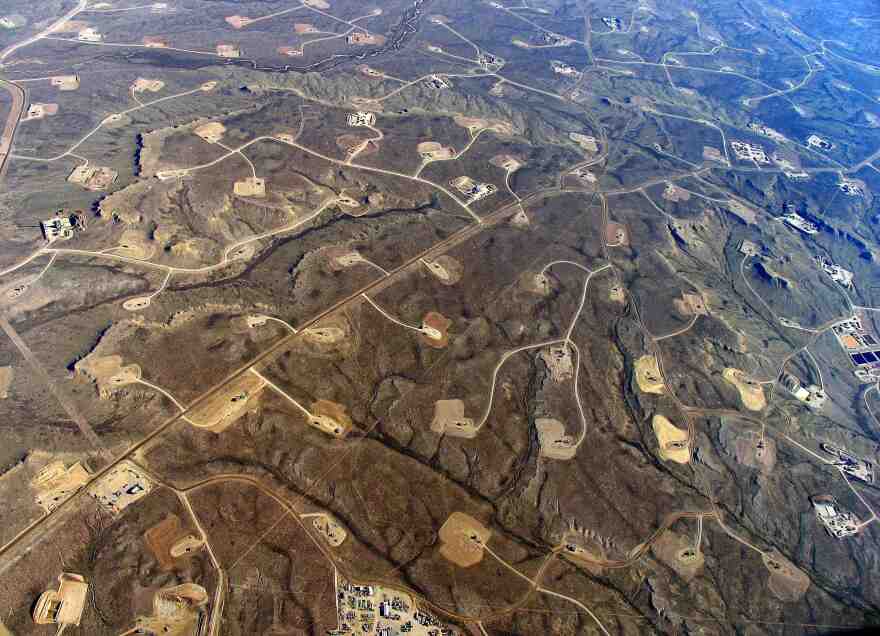Larry Hecht runs Pier-48, an intermodal terminal on the Ohio River for loading and off-loading barges. At the height of the shale boom, it got 25 bulk shipments of drilling supplies like barite a month.
Then came the bust, and that traffic stopped.
But during those up-times, Hecht had expanded the pier’s materials-handling capabilities, so he found new materials to handle.
“I had the opportunity to do soy beans, because I can off-load a soybean barge through the conveyer,” Hecht says. “And that was really my lifesaver for that period, that lull. It was the soybeans. I actually did some corn, too.”
Now, Hecht says the adjusting he did to keep the business going is about to pay off. Advanced bookings are coming in from drillers again, and Hecht believes that’s a sign energy companies are gearing up for a new run at the Utica Shale.
Ohio’s oil and gas drilling boom started in 2010, peaked in 2013 and has been fading since then. But Hecht isn’t the only one seeing it may be picking up again.

Was The Bust Really A Bust?
Andrew Thomas, executive-in-residence of Cleveland State University’s Maxine Goodman Levin College of Urban Affairs, thinks so too. The university just finished a study of Ohio‘s shale play, and he says it has unique economic factors to carry it forward.
For one, Ohio is not what's called an “extractive economy.”
“We are not like Oklahoma where we make our living off oil and gas upstream business,” Thomas says. “The Ohio economy uses oil and gas, especially natural gas. So, the fact that we have these depressed prices is spurring a lot of that economic activity in Ohio.”
Another thing about the Utica Shale boom is that the bust didn’t really act that way, at least not in terms of unemployment and careers ending in the region.
When the oil and gas markets collapsed, energy infrastructure-building was well under way in Ohio. So, whether for welders or engineers, many jobs just shifted from drilling to pipelines and power plants.
Attorney Alan Wenger practices law in the energy sector and follows the industry closely. He says the trained workers are still here and actively pursuing their careers.
“Those folks, they may have to travel a few hours and stay in hotels, but they have work,” Wenger says. “There’s no question.”
Not everyone is enthusiastic about a drilling comeback, of course.

Boom For Whom?
General environmental concerns remain, as do specific concerns about the quality of the work being done. Those were raised by problems such as the Rover Pipeline's leak during construction, contaminating wetlands in Stark County.
And there are individuals with personal property concerns — raised by people like Jim Kiefer, after a compressor station was put next to his Carroll County house.
"And they say, 'We’re gonna start using explosives.’ And I said I was never informed. ‘Well somebody should’ve told you,’” Kiefer recalls. "And within a couple minutes it was like something in a World War II movie: this huge explosion and the dirt and rocks flew up in the air. And the sound waves just moved through the home and terrified me and the dogs. And it was just awful.”
Paul Feezel, a financial consultant, heads the conservation group Concerned Citizens of Carroll. As he watches renewed truck traffic passing Carrollton’s square, he says a return to drilling does seem likely.
But he expects it to be less positive than people expect.
“There’s no doubt that there are people who say, 'Come back, I want my share. Come drill my property,’” Feezel says. “But I have a feeling those people are still thinking about the boom kind of numbers, not the kind of numbers that are out there now at the oil prices we’ve got, and the liquids prices we’ve got.”

Cleveland State’s study shows that over the past five years – even with half of that time in the downturn – Ohio’s shale play drew $54.7 billion in investment.
Thomas says that early on, while drilling was still active, a lot of that money went to companies and workers from out-of-state. But later, with the shift to infrastructure-building, most of it stayed here.
“On the post-drilling side, which has to do with handling and storage and piping, that’s probably closer to 70 or 80 percent,” Thomas says.
In the shale fields, the drilling-rig count is slowly increasing. Around the region, projects that can create sustained demand for eastern Ohio natural gas here are in the works, including $12 billion in chemical processing complexes and 11 new gas-fired power plants.





